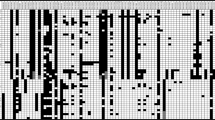Abstract
Twenty-four tetraploid Indian potato cultivars were characterized by using RAPD markers to assess diversity within and between late blight resistant and susceptible cultivars. Sixty-four random decamer primers generated802 fragments, ranging in size from 60–3200 bp, with 96.4% fragment polymorphism. Shannon's index of diversity was used to quantify the degree of variability present within and between the variety types. Most of the diversity was detected within variety types, with 88% of variation being within and 12% being between the resistant and susceptible cultivars. No clear groupings based on late blight resistance and susceptibility or kinship was reflected on the dendogram. The late blight resistant cultivars exhibited higher variability compared to susceptible cultivars and they were more dispersed on the PCO plot.
Similar content being viewed by others
References
Birhman, R.K. & M. Cappadocia, 1998. DNA fingerprinting (RFLPs and RAPDs) in potato. In: S.M. Paul Khurana, R. Chandra & M.D. Upadhya (Eds.), Comprehensive Potato Biotechnology, pp. 73–96. Malhotra Publishing House, New Delhi.
Chakrabarti, S.K., R.K. Birhman & D. Pattanayak, 1999. Genetic similarity analysis and identification of Indian potato cultivars by random amplified polymorphic DNAs. Indian J Exp Biol 37: 1123–1128.
Demeke, T., D.R. Lynch, L.M. Kawchuk, G.C. Kozub & J.D. Armstrong, 1996. Genetic diversity of potato determined by random amplified polymorphic DNA analysis. Plant Cell Reports 15: 662–667.
Doyle, J.J. & J.L. Doyle, 1987. A rapid DNA isolation procedure for small quantities of fresh tissue. Phytochem Bul 19: 11–15.
Gaur, P.C., P.K. Gupta & Hari Kishore, 1978. Studies on genetic divergence in potato. Euphytica 27: 361–368.
Gaur, P.C., P.S. Naik, S.K. Kaushik & S.K. Chakrabarti, 1999. Indian Potato Varieties. Technical Bulletin No. 51. CPRI, Shimla.
Hosaka, K. & R.E. Jr. Hanneman, 1994. Random amplified polymorphic DNA markers detected in a segregating hybrid population of Solanum chacoense × S. phureja. Jpn J Genet 69: 53–56.
McGregor, C.E., C.A. Lambert, M.M. Greyling, J.H. Louw & L. Warnich, 2000. A comparative assessment of DNA fingerprinting techniques (RAPD, ISSR, AFLP and SSR) in tetraploid potato (Solanum tuberosum L.) germplasm. Euphytica 113: 135–144.
Milbourne, D., R. Meyer, J.E. Bradshaw, E. Baird, N. Bonar, J. Provan, W. Powell & R. Waugh, 1997. Comparison of PCRbased marker systems for the analysis of genetic relationships in cultivated potato. Mol Breed 3: 127–136.
Nei, M. & W.H. Li, 1979. Mathematical modeling for studying genetic variation in terms of restriction endonucleases. Proc Natl Acad Sci USA 74: 5267–5273.
Paul, S., F.N. Wachira, W. Powell & R. Waugh, 1997. Diversity and genetic differentiation among populations of Indian and Kenyan tea (Camellia sinensis (L.) O. Kuntze) revealed by AFLP Markers. Theor Appl Genet 94: 255–263.
Quiros, C.F., A. Ceada, A. Georgescu & J. Hu, 1993. Use of RAPD markers in potato genetics: Segregations in diploid and tetraploid families. Am Potato J 70: 35–42.
Rohlf, F.J., 1998. NTSYS-pc. Numerical Taxonomy and Multivariate Analysis System, Version 2.0. Exeter Software, New York.
Singh, B.P., T.A. Joseph & S.K. Kaushik, 1999. Breeding for disease resistance. In: B.P. Singh & G.S. Shekhawat (Eds.), Potato Late Blight in India. Technical Bulletin No. 27, pp. 55-69. CPRI, Shimla.
Sosinski, B. & D.S. Douches, 1996. Using polymerase chain reaction-based DNA amplification to fingerprint North American potato cultivars. HortSci 31: 130–133.
Spooner, D.M., J. Tivang, J. Nienhuis, J.T. Miller, D.S. Douchas & M.A. Contreras, 1996. Comparison of four molecular markers in measuring relationships among the wild potato relatives Solanum section Etuberosum (subgenus Potatoe). Theor Appl Genet 92: 532–540.
Umaerus, V. & M. Umaerus, 1994. Inheritance of resistance to late blight. In: J.E. Bradshaw & G.R. Mackay (Eds.), Potato Genetics, pp. 365–401. CAB International, Wallingford.
Wastie, R.L., 1991. Breeding for resistance. In: D.S. Ingram & P.H. Williams(Eds.), Advances in Plant Pathology, vol 7: Phytophthora infestans, the cause of late blight of potato, pp. 193–223. Academic Press, London, San Diego, New York, Sydney, Tokyo, Toronto.
Welsh, J. & M. McClelland, 1990. Fingerprinting genomes with PCR with arbitrary primers. Nucleic Acids Res 18: 7213–7218.
Williams, J.G.K., A.R. Kubelik, K.J. Livak, J.A. Rafalski & S.V. Tingey, 1990. DNA polymorphisms amplified by arbitrary primers are useful as genetic markers. Nucl Acids Res 18: 7213–7218.
Young, N.D., 1996. QTL mapping and quantitative resistance in plants. Annu Rev Phytopathol 34: 479–501.
Author information
Authors and Affiliations
Rights and permissions
About this article
Cite this article
Pattanayak, D., Chakrabarti, S.K. & Naik, P.S. Genetic diversity of late blight resistant and susceptible Indian potato cultivars revealed by RAPD markers. Euphytica 128, 183–189 (2002). https://doi.org/10.1023/A:1020861225738
Issue Date:
DOI: https://doi.org/10.1023/A:1020861225738




